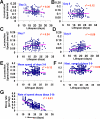Identification by machine vision of the rate of motor activity decline as a lifespan predictor in C. elegans
- PMID: 18255194
- PMCID: PMC2747634
- DOI: 10.1016/j.neurobiolaging.2007.12.007
Identification by machine vision of the rate of motor activity decline as a lifespan predictor in C. elegans
Abstract
One challenge in aging research concerns identifying physiological parameters or biomarkers that can reflect the physical health of an animal and predict its lifespan. In C. elegans, a model organism widely used in aging research, motor deficits develop in old worms. Here we employed machine vision to quantify worm locomotion behavior throughout lifespan. We confirm that aging worms undergo a progressive decline in motor activity, beginning in early life. Importantly, the rate of motor activity decline rather than the absolute motor activity in the early-to-mid life of individual worms in an isogenic population inversely correlates with their lifespan, and thus may serve as a lifespan predictor. Long-lived mutant strains with deficits in insulin/IGF-1 signaling or food intake display a reduction in the rate of motor activity decline, suggesting that this parameter might also be used for across-strain comparison of healthspan. Our work identifies an endogenous physiological parameter for lifespan prediction and healthspan comparison.
Figures



References
-
- Alcedo J, Kenyon C. Regulation of C. elegans longevity by specific gustatory and olfactory neurons. Neuron. 2004;41(1):45–55. - PubMed
-
- Altun M, Bergman E, Edstrom E, Johnson H, Ulfhake B. Behavioral impairments of the aging rat. Physiol Behav. 2007 - PubMed
-
- Apfeld J, Kenyon C. Cell nonautonomy of C. elegans daf-2 function in the regulation of diapause and life span. Cell. 1998;95(2):199–210. - PubMed
-
- de Bono M, Maricq AV. Neuronal substrates of complex behaviors in C. elegans. Annu Rev Neurosci. 2005;28:451–501. - PubMed
-
- Dillin A, Hsu AL, Arantes-Oliveira N, Lehrer-Graiwer J, Hsin H, Fraser AG, Kamath RS, Ahringer J, Kenyon C. Rates of behavior and aging specified by mitochondrial function during development. Science. 2002;298(5602):2398–401. - PubMed
Publication types
MeSH terms
Substances
Grants and funding
LinkOut - more resources
Full Text Sources
Other Literature Sources
Medical

